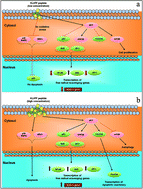Tjernberg peptide: a double edged sword in Alzheimer’s disease†
Abstract
Alzheimer’s disease is a neurodegenerative disorder affecting millions of people worldwide, clinically manifested by the presence of amyloid plaques and neurofibrillary tangles. Senile plaques are composed of amyloid beta protein, while neurofibrillary tangles are formed by the hyperphosphorylation of tau protein. A plethora of reports on the anti-oxidant and pro-oxidant properties of amyloid beta peptides are available. However the molecular candidates involved in bringing about this therapeutic behaviour have not been explored. To investigate this phenomenon we have used a pentapeptide sequence, KLVFF, derived from the core-recognition motif of amyloid beta peptides to study the altered signaling cascade in neuronal cells. Our data showed the unique dual behaviour of the KLVFF peptide as a pro-oxidant and toxicant based on the dosage concentration. The peptide’s inherent ability to scavenge free radicals at low concentrations <100 μM to offset oxidative stress was proved by the down-regulation of SOD1, AP-1 and FoxO3a genes. However at concentrations >100 μM, the cytotoxic effect of the peptide dominates, leading to apoptosis through the activation of p53, ERK1 and p38 in a caspase-dependent mechanism accompanied by mitochondrial membrane depolarization. The therapeutic role of the KLVFF peptide stems out from the regulation of the SOD1 gene by AP-1 and NF-κB and the Nrf2 gene to regulate the intracellular glutathione levels. Collectively our experimental findings revealed a threshold concentration of 100 μM, beyond which the KLVFF peptide mimics the amyloid beta of senile plaques, which can be used as a model system to understand the pathological role of amyloid beta peptides. Concentrations below 100 μM may be actively employed for therapeutic applications to prevent the further aggregation of amyloid beta.


 Please wait while we load your content...
Please wait while we load your content...